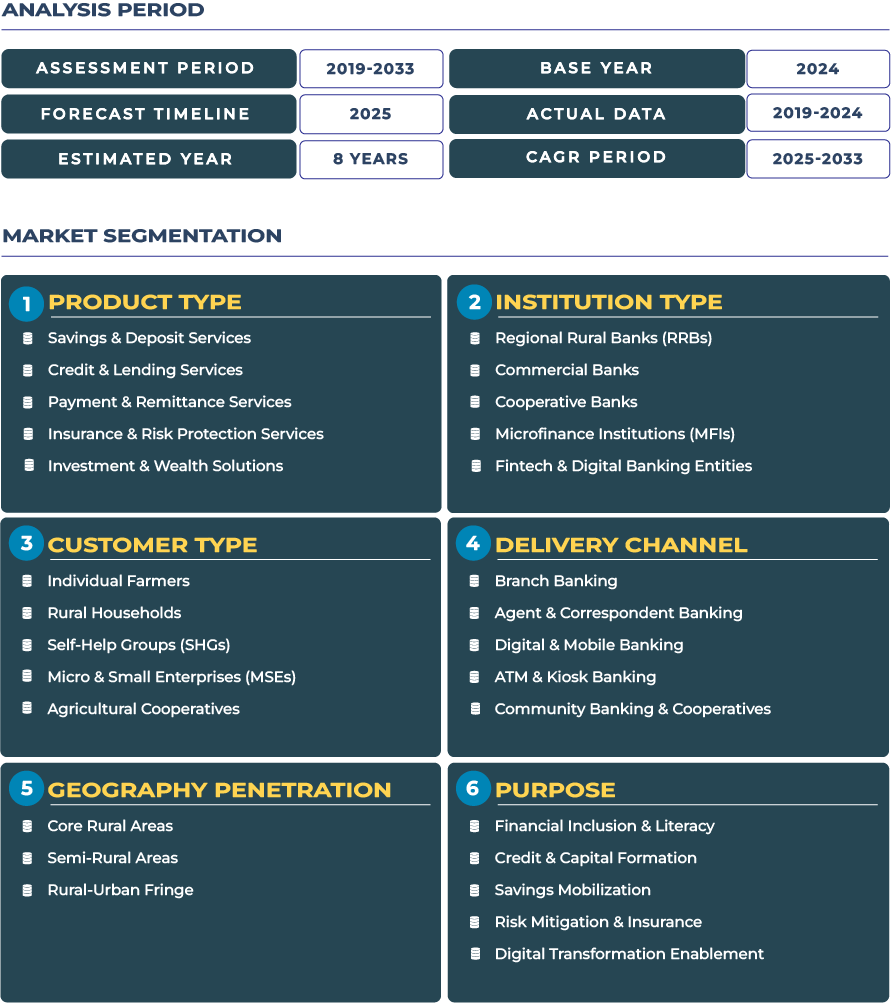Thailand Rural Banking Market Outlook: Tourism-Linked Prosperity Fuels Financial Inclusion
Thailand rural banking market is witnessing a profound transformation, fueled by the country’s unique integration of tourism and rural livelihood finance. As one of Southeast Asia’s most tourism-dependent economies, Thailand’s villages have long been the backbone of both its agricultural output and cultural tourism appeal. This interlinkage is now reshaping rural banking practices, from microcredit for homestays to agricultural-linked savings instruments. The nation’s banks, under the guidance of the Bank of Thailand, are strengthening the financial inclusion ecosystem, enabling rural communities to access sustainable and affordable banking services.
Note:* The market size refers to the total fees/revenue generated by banks through various services.
In 2025, Thailand rural banking industry is valued at USD 12.9 billion and is projected to reach USD 20.1 billion by 2033, expanding at a CAGR of 5.7% (2025–2033). This growth trajectory is supported by expanding digital penetration, government-led community fund initiatives, and a gradual rebound of rural tourism post-pandemic. As a result, the rural financial landscape is evolving from a subsistence-driven model to a diversified, digitally-enabled credit ecosystem that empowers both farmers and microentrepreneurs.
Tourism-Led Livelihood Finance Redefining Thailand’s Rural Economy
Thailand’s rural finance ecosystem is being redefined through the synergy of tourism and agricultural livelihoods. Programs under the Ministry of Finance and the Government Savings Bank (GSB) have driven credit accessibility in rural districts by linking tourism income forecasts to microloan eligibility. As homestay tourism and agri-tourism rise across northern provinces such as Chiang Mai and Loei, banks are leveraging tourism data to build alternative credit scoring systems. These innovative financial models enable rural families to access working capital during off-seasons and repay loans during peak tourist inflows.
The market’s steady expansion is also driven by enhanced risk protection and micro-insurance services for seasonal earners. Insurers are now bundling credit products with crop and accident insurance, providing greater stability to rural borrowers. Furthermore, Thailand’s strong mobile banking infrastructure, spearheaded by institutions like Bangkok Bank, ensures seamless payment and remittance services across remote provinces. Collectively, these developments position Thailand rural banking sector as a critical pillar of the country’s inclusive growth model.
Drivers & Restraints: Balancing Agricultural Modernization with Rural Volatility
Strong Contract-Farming and Village Funds Empower Rural Prosperity
The expansion of Thailand rural banking market is underpinned by an established framework of contract farming and village savings mobilization. Large-scale contract arrangements for tropical fruit exports, particularly durians, longans, and mangosteens, are supported by financial instruments that provide growers with pre-harvest loans. The Comptroller General’s Department has also reinforced the Village and Urban Community Fund, enhancing the liquidity of local financial cooperatives. As a result, rural credit and deposit services are becoming more structured, promoting entrepreneurship and local economic resilience.
Tourism Dependence and Informal Borrowing Hamper Sustainable Growth
Despite the encouraging trajectory, challenges persist. The rural banking sector remains vulnerable to external shocks, particularly due to its high dependence on tourism. Volatile visitor numbers during global crises, such as pandemics or geopolitical tensions, can destabilize rural incomes, leading to loan repayment delays. Additionally, a large share of Thailand’s rural economy still relies on informal documentation, complicating credit verification and asset collateralization. Addressing these systemic issues requires deeper financial literacy programs and stronger integration between banks and community organizations.
Trends & Opportunities: Digital Inclusion and Tourism-Finance Convergence
Tourism-Agriculture Bundling Driving Rural Credit Innovation
A defining trend in Thailand rural banking landscape is the bundling of tourism and agriculture-linked financial products. Banks are designing hybrid loans that combine income projections from both sources, enabling borrowers to diversify risk. For instance, in Chiang Rai and Nan, regional cooperatives are adopting tourism-linked microcredit programs for families operating both homestays and farms. The digitization of these programs through mobile platforms and smart identity systems is creating a transparent, scalable model of financial empowerment.
Emerging Opportunities in Homestay Loans and SME Export Financing
With rising global demand for Thai processed fruit exports and cultural tourism, rural SMEs are securing opportunities in value-added agriculture. Banks are increasingly offering community-based homestay loans and working-capital lines for export-focused cooperatives. These initiatives align with Thailand’s One Tambon, One Product (OTOP) movement, boosting local entrepreneurship. Moreover, digital payment solutions have penetrated deeply into rural areas, with QR-based transactions simplifying remittance and savings for informal earners. This convergence of financial inclusion and tourism innovation presents a long-term growth frontier for the market.
Competitive Landscape: Local Institutions Lead Inclusive Growth through Financial Innovation
Thailand rural banking ecosystem features a combination of national retail banks, digital-first institutions, and cooperative banks driving rural innovation. In August 2025, the Bank introduced a blended-loan program for village homestays, integrating tourism income forecasts into repayment cycles. This development reflect the sector’s transition from traditional microfinance to analytics-driven lending models.
Collaborations between the Bank of Thailand and international development institutions have further strengthened rural credit infrastructure. Through digital transformation and partnership-driven strategies, local banks are positioning Thailand as a model for tourism-linked financial inclusion in ASEAN. As technology deepens, the Thai rural banking sector is expected to witness further product diversification, enabling farmers, artisans, and micro-entrepreneurs to participate fully in the digital financial ecosystem.







